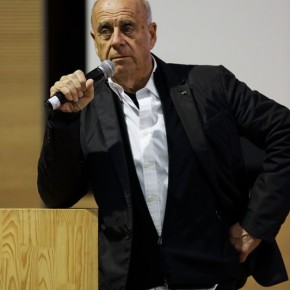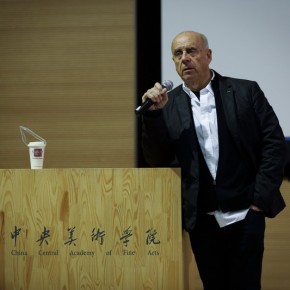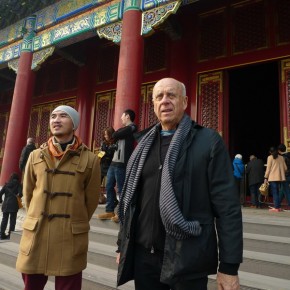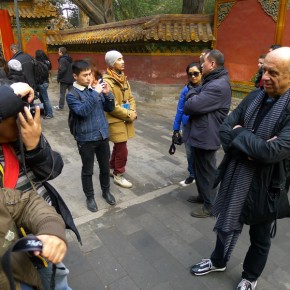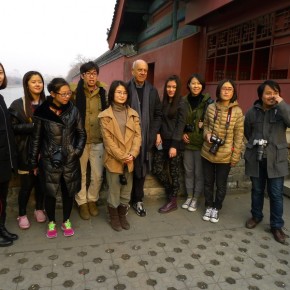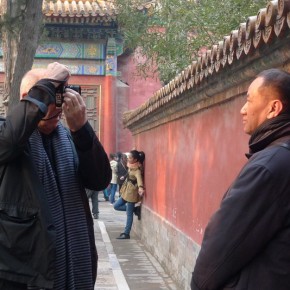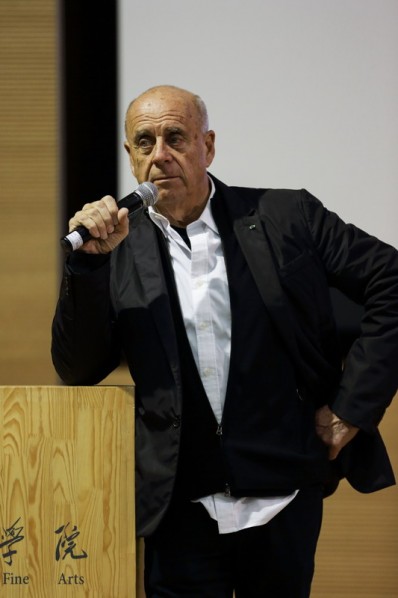
On the second day of the famous American photographer Ralph Gibson’s teaching in CAFA, on March 26, 2013, he gave a lecture in the morning, and practiced photography in the afternoon. Invited by the Department of Oil Painting, CAFA, Ralph Gibson, began his 3 day academic exchange activities at CAFA, on March 25, 2013. Presided over by Xie Dongming, Director of the Department of Oil Painting, Vice President of the School of Plastic Arts, the lecture was held at the Academic Lecture Hall of the CAFA Art Museum, Zhou Yi was the translator. After the lecture, Ralph and Xie Dongming led the students from the Departments of Photography and Oil Painting to practice photography in the Palace Museum, and then shared valuable experiences.
50 years career as a photographer - the pursuit of “purity”
In the morning lecture, Ralph spent an hour introducing the five decades of his photographic career and the pursuit of the “purity”, and answered the questions from the audience. Ralph was born in Los Angeles, his father served as Hitchcock’s assistant, working in a Hollywood studio, this environment for growth exerted a great influence on his photography. When he was about 13 years old, his parents divorced, and he entered the Navy at the age of 16, afterwards he went to a photographic school to learn for fortuitous reasons, but once again dropped out. At the age of 17, he returned to the photographic school, determined to be a photographer. During his Navy career before the age of 21, he had tried to learn all the photographic techniques. Later he went to learn at the San Francisco Academy of Fine Arts, working as an assistant for the famous photographer Dorothea Lange, when he showed his own works to Dorothea, she said his problem was that there was no point for departure, which was needed to show the intention in photography. In 1961, when he was 21 years old, he photographed the first photo with a Leica, and then deciding to use only the Leica camera, as a documentary journalist photographer, in addition, he was interested in the lines of the patterns.
Ralph showed his early works in a slide show, in order to let the audience understand the development of his photography. Back in Los Angeles, Ralph worked for a graphic designer, but he still wanted to be a documentary photographic journalist. In 1967, he went to New York to shoot photos in an “edit” type. He was then employed by an organization in Miami as he had financial difficulties. Gradually, his photos became more complex, and the characteristics of the pattern appeared more frequently, he found the reality like dreams from the camera, slowly losing interest in the reality of the documentary. Then Ralph planned and published a book, entitled “Sleepwalker”, where the point for departure of each photograph was a dream. During this time he had been in cooperation with the director Robert Frank. Among the slideshows there was a photo of a fire in a barbershop, he explained, after the divorce of his parents, his mother had managed a beauty salon, and later died in a fire in the beauty salon. He said, he cried no tears at his mother’s funeral. After a few years, in the streets of New York he saw a beauty salon on fire, when he was ready to shoot, he could not prevent his tears. At that time he knew he was not going to be a commercial photographer, but found himself through the medium of photography.
The publication of “Sleepwalker” made Ralph quickly famous, and soon he began to go around to exhibitions and lectures, and set up his own awards and fund. The second publication was about daily scenes, he began to try to use the style of “group paintings” to showcase his works, so that the space for the different photos was in contrast to the inside distance of the photo, changing the viewer’s vision when viewing a picture. He said, in the book he could unify the viewers, establishing an equal viewing outlook. The third book he published was on his memories of his Navy experience and later he published books in cooperation with a guitarist. He said when he photographed in France, he was interested in the buildings’ shadows, which were a new point of departure, shooting an object fixed in the distance at one meter. For him, the role of the frame became the thinking object, he tried to place people at the edge of the photographic frame, suggesting activities outside the frames. In the slideshows, the male bust dressed in a suit was one of his masterpieces, he thought the four frames pushed forward so you could almost scratch the object, the surface of the picture was like a taut drumhead. For him, the photos mean nothing, the medium and photography are themselves. Subsequently, he showed the pictures taken when he returned to France, as well as the photographs of Italy and Brazil, talking about his feelings in different places, based on the feelings in different places, the rare color photographs appeared (he thought color photos are not as dramatic as the black-and-white photographs, so most of the photos are black and white). In Egypt he had photographed the shapes from sails and followed them, the shape became a new point of departure. He believes that every photograph is a discovery, even a brick wall, and he said he did not mind taking pictures of well-known tourist attractions.
In the Q & A section, Ralph said, there were two very important points for thinking about: firstly, what you want to shoot; secondly, when you decide to shoot something, where would you shoot? When talking about the differences between a commercial photographer and pure art photographer, he believes that they are not separated by good or bad, perhaps, a commercial photographer works for money, while a pure art photographer spends money shooting the work. When talking about the changes of present photographic mediums, he believes that a good photographer should find the unknown from internal of medias, As for the impact of painting on him, he said he hoped that the artworks introduced him to a new perspective, as Flaubert once said: “There is not only the truth, only perspectives.” When the audience asked for Ralph’s suggestions to Chinese students, he said that he found the generation were keen for success, sometimes it was good, sometimes it would hurt you, and the real issue is: Who are you creating for? For yourself or for others? Ralph said he created for himself, because he needed the feeling of these works. He believed that all great artists had their personal way of working. Viewing the works of the Chinese students, he found that many works reflected the society where the photographer lived, he reminded the Chinese students to think of the relationship between their current and previous works, desiring to reflect China, or to create a new paradigm.
Photographic practice at the Palace Museum
Ralph, together with the students from the Departments of Photography and Oil Painting, photographed and created at the Palace Museum, on the afternoon of March 26, and he hoped that the students captured memories of the Earth, freezing the most nostalgic scene as if it was the end of the world, at the same time, every person had his/ her personal point of departure when taking photographs. During the shooting process, he said it was a very difficult task, because of the crowd of people, and grand scenes, he reminded them that rather than indulge in capturing the object, to feel the object was capturing you. He selected some of the details of the Palace Museum, instead of shooting the grand scenes or the crowd. After the shooting, he said his point for departure was Chinese red, which he was not clear about and he called it “The Emperor’s red”, he thought the important significance to him of this photographic experience was that he had visited he place.
Journalist: Duan Ziying, Translation: Chen Peihua/CAFA ART INFO
Photography: Hu Zhiheng, the Department of Photography at CAFA




